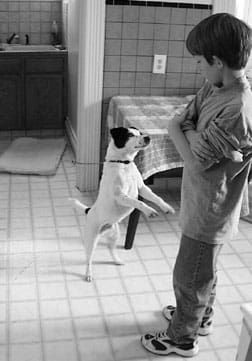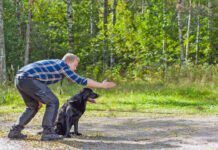Week 2 of my Peaceable Paws Good Manners class, I ask the question, “How many of your dogs jump up on people?” Generally at least 80 percent of the dog owners in class raise their hands. “Why do they jump up?” I ask.
I usually get at least one incorrect answer of “Dominance!” but most of my students realize their dogs jump up for attention. And because much of the time the behavior is successful, it’s a challenging one to extinguish.

Be consistent
Consistency is the cornerstone – and the bane – of training success. Consistent reinforcement of polite doggy greetings is reasonably easy. The tough part is ensuring that impolite greetings are consistently not reinforced. Even if you are very good at not reinforcing your dog’s jumping up behaviors, the entire rest of the world is pretty crummy at it. If jumping up is reinforced randomly, it’s very difficult to extinguish.
Paul (my husband) and I are very consistent at not reinforcing our Corgi for jumping up. Lucy is now very good at not jumping up – on us. She still wants to jump on everyone else she sees, so we persistently work on preventing her from being reinforced by everyone else.
I teach my students a three-step process for changing a behavior you don’t want. It’s perfect for applying to rude greetings:
• Step 1: Visualize the behavior you do want. Instead of thinking, “I wish my dog wouldn’t jump on people,” have an image in your mind of the behavior you’d prefer to see: “I’d like my dog to greet people by sitting politely in front of them.
• Step 2: Prevent your dog from being reinforced for the behavior you don’t want. This means taking appropriate management steps to proactively intercede before Bounder plants his paws on a guest’s shoulders. Your persistent removal of reinforcement for jumping isn’t enough; you have to convince the entire rest of the world to follow suit.
• Step 3: Generously and consistently reinforce the behavior you do want. Simply ignoring an undesirable behavior leaves a behavior vacuum. Unless you generously reinforce an alternative behavior, your dog will likely default to the behavior he knows, that has worked for him in the past. Constantly be on the lookout for polite greeting sits. Be sure to greet your dog when he offers them. It’s human nature that we tend to overlook good behavior and respond to bad behavior. Turn that around.
Practice makes perfect
The three-step process sounds easy in principle. It’s not always so easy in practice. You’re most likely to encounter problems with greeting immediate family members, greeting guests in your home, and greeting people in public. Let’s look at how you could apply the three-step process in each of these scenarios.
Greeting family members
In theory, this should be the easiest of the three scenarios, since family members are around very frequently and should be committed to helping you change the behavior. In reality, we know how hard those darned humans can be to train! (Remember that positive reinforcement works well with primates, too!)
You can try several different approaches with family members. First, all must agree to stop reinforcing your dog for jumping, and must all understand that any attention at all is reinforcement. Making eye contact with your dog when he jumps up is reinforcing him. By pushing him off, you’ve touched him – reinforcement! Asking him to “Off!” gives him attention by speaking to him. Reinforcement! In fact, just the fact that his paws touched you can be rewarding to your dog, even if you do nothing else.
To avoid reinforcing your dog for jumping up, he needs to get the opposite response. Rather than eliciting attention, a jump should make all attention go away. When Bounder starts his lift-off, say “Oops!” as you turn your back on him and step away. If he jumps again, turn and step away again. Keep an eye over your shoulder, and when he stops jumping (and, we hope, sits), turn back toward him and give him treats and/or attention.
Meanwhile, use a tether to teach him a more appropriate greeting. You can secure your dog with a leash, but a more durable tether consists of a four- to five-foot piece of plastic coated cable with sturdy snaps on both ends. Attach it to an adequately heavy piece of furniture, or create a tether station by screwing an eyebolt into a wall stud and clipping the tether to it. Alternatively, you can screw an eyebolt into a 2 x 4 block of wood, clip the tether to it, and slide it under a door that, when closed, holds your dog in place.
With Bounder on his tether, approach from a distance. If he’s leaping about in greeting, stand still until he’s calm, then move forward. Anytime he starts to jump, stand still, or even take a step back. When you are close enough to reach out and touch him (but he still can’t jump on you), stand still and wait for him to sit. You can help him get the idea by holding a treat at your chest a few times, but you’ll want to fade the treat (stop using it) quickly so he learns to offer a sit in greeting without being lured. By the same token, don’t ask him to sit – wait for him to offer it. You want him to volunteer the sit in greeting, not wait to be asked for it.
When he sits, mark the polite behavior with a “Yes!” or the click! of a clicker, feed him a treat, and give him attention. Repeat this exercise until he sits promptly as soon as you head toward him. Many dogs will immediately resume jumping up when petted, especially if they have been allowed to greet people boisterously in the past. If your dog starts to leap up as you reach for him or pet him, simply stand up, take a step backward (out of his range), and wait for him to sit again. You may have to withdraw and return several times in rapid succession before he realizes that leaping up makes the thing he wants (attention) go away, and sitting firmly on his bottom makes it return.
Now have the rest of the family practice, all the way down to the toddler.
Of course, your dog won’t always be on a tether, but when he has learned this exercise he’ll be much quicker to offer you (and others) that highly reinforced “sit” behavior in other scenarios as well.
Perhaps the most aroused greetings occur when you return home after a long day away. Bounder is clearly thrilled to see you, and it can be hard to turn your back on such a sincere display of love. Our human family members should greet us with this much enthusiasm, day after day!
If you are reluctant to squelch your dog’s welcome-home enthusiasm, redirect it to a game you both can enjoy. Stash your dog’s favorite toy – or several – in a box just outside the door. Walk into the house with the toy in your hand, and toss it for him to fetch. Even better, reinforce polite greetings by waiting for a sit before you toss. The “welcome home fetch game” allows your dog to be happy about your return, lets you reciprocate, and still keeps his energy controlled and directed into a productive and polite outlet. It’s also easy to transfer to children and visitors!
You may have a family member who insists that he wants Bounder to be able to jump on him. Promise your body-slammer masochist that he can teach Bounder to jump up on cue – after the dog has learned to greet politely. That might motivate him to help with, rather than sabotage, Bounder’s training. Then, when the two of you are ready to teach “Jump up!” be sure you select verbal and body language cues that are very distinctive, and not likely to be offered by accident by an unsuspecting dog greeter.
Greeting guests in your home
Of course, it’s too much to expect that visitors will know enough to turn their backs on your dog when he jumps up on them, so it’s incumbent on you to make sure he doesn’t have the opportunity. Your tether will come in handy here. When the doorbell rings, calmly clip him to his tether station, feed him a yummy treat, then go greet your guests. You don’t have to worry about a door-darting dog, or one who blithely ruins your guest’s nylons. Peace of mind. Over time, Bounder may even come to learn that the doorbell is the cue to go to his tether and wait for treats!
If necessary, leave a tab (a four- to six-inch piece of leash) or a house lead (a four- to six-foot light line) attached to your dog’s collar so he’s easy to gather up and tether. Be sure to remove these when you’re not home, to prevent tangling accidents.
As your guests enter, hand them a few treats, and ask them to approach Bounder on his tether. Be sure they understand that they can feed him the treats and pet him only when he is sitting. Then supervise to be sure they follow directions.
When your dog’s initial excitement subsides, you can release him to greet your guests off leash. By then, you will have had time to instruct them on how to properly reinforce his polite greeting, and how to avoid reinforcing him if he does try to jump.
You can also choose to play the “welcome fetch” game with visitors. Put a large sign on your door instructing visitors to take a toy from the box, bring it in the house with them, and throw it for Bounder when he sits. Dog-loving visitors – the only kind who come to my house! – will enjoy this immensely. Remove the sign when you’re not home, so burglars don’t learn the trick of getting past your guard dog!
Greeting people in public
In public, your leash is the tether. Hold the leash, giving your dog only about three feet of slack. As people approach, keep your distance and the leash at a length that prevents your dog from lunging forward and jumping up on the passerby. You can, of course, reinforce your dog if he offers a sit. If the approachers appear to have dog-petting on their minds, ask (insist!) that they wait for him to sit first. If they say, “That’s okay, I don’t mind if he jumps up,” politely but firmly tell them that you mind, and that they need to wait until Bounder sits. If they ignore your instructions, turn and walk away with your dog, with a cheery “Oops! Sorry!”
If they are willing, you can hand them a couple of treats to feed when your dog sits. If they seem really interested, ask them if they’ll help you train. Give them a handful of treats and ask them to do several approach-sit repetitions to give Bounder more practice at greeting strangers politely on the street.
Fearful greetings
So far, we have presupposed an overenthusiastic greeter, whose behavior is best addressed with positive reinforcement and negative punishment principles of operant conditioning, where the dog’s behavior (a polite sit) causes a good thing to happen (attention), and jumping up causes that same good thing to go away.
Some dog owners have the opposite problem: the dog who launches a volley of defensive fear-barking at the sound of the doorbell or the approach of a stranger on the street. This behavior is best modified through the use of counter-conditioning: changing the dog’s association with visitors and strangers from “Bad! Scary!” to “Yay, treats are coming!”
You might begin by ringing the doorbell yourself, and immediately follow the sound with several tidbits of canned chicken (or something equally succulent and delicious), delivered to your dog’s waiting jaws, even if he’s barking. Repeat this exercise until the sound of the doorbell generates a “Yay! Where’s my chicken?” response instead of wild barking.
Then have someone else ring the doorbell – someone your dog knows. Repeat the doorbell-chicken sequence until you’re getting the positive response. Then have the person ring the bell and open the door. This is likely to elicit another round of defensive barking. Feed chicken. Then repeat, and continue repeating until the doorbell/door opening sequence consistently generates the “Where’s my chicken?” response from your dog. Then have the person ring the bell, open the door, and step into the room.
Continue the progression, one small step at a time, feeding chicken at each step until you get the positive response at that level, then take the next step. When he’s fine with the person he knows, try someone he doesn’t know, or at least doesn’t know as well, until he can maintain calm when anyone enters the house.
You can do a similar exercise with people on the street. Set yourself up a distance off the sidewalk so people aren’t walking directly at your dog. The instant he notices someone walking in your direction, start feeding him bits of chicken. When the person has passed by, stop. Over time, as he associates people approaching with yummy chicken, his response should become calmer.
Important note: Do not have the other person feed treats to a fearful dog. His desire for the treat may overcome his caution, temporarily, but when the treat is gone and he realizes he’s too close to a person who scares him, he may bite. You need to first change the association by feeding your dog the treats yourself. When your dog is happy to have visitors and strangers in close proximity, then you can ask the other person to drop treats, or offer them gently using very nonthreatening body language: kneel sideways to the dog, hold the treat out to the side, don’t make direct eye contact or any overt moves to reach for the dog.
If you are consistent and persistent, your dog can learn to greet people politely. In fact, he will soon run up to you and sit as hard and as fast as he can, with as much enthusiasm as he now displays when he jumps up on you. After all, dogs do what works. If you can manage matters so the behavior you want is the behavior that works for your dog, everybody wins!






